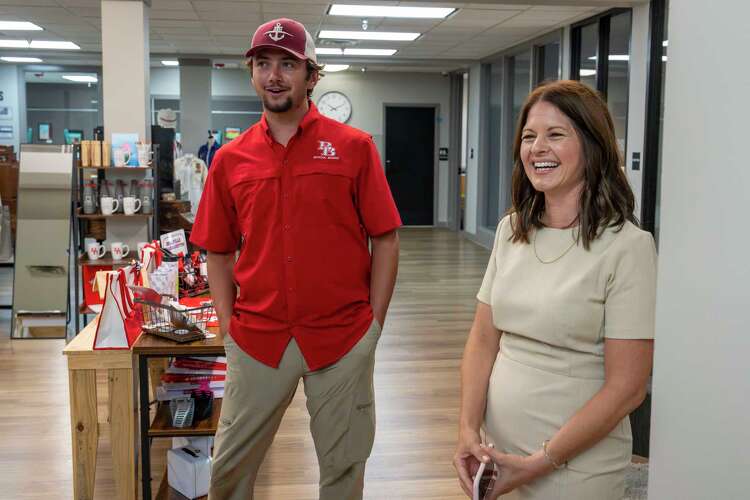
A Town with a Rich Heritage and a New Approach to Education
Bellville, Texas, is a town where history is woven into the fabric of daily life. From the German-sounding last names on storefronts to the round "Turnverein" dance hall and the traditional sausages sold at the downtown meat market, the town's cultural roots are evident everywhere. Founded by a member of Stephen F. Austin's "Old Three Hundred," Bellville has long been known for its strong sense of community and historical significance.
Yet, despite its deep heritage, Bellville is not shy about embracing modernity. Travelers passing through from Houston might be surprised to find a Trump Burger flagship restaurant, Austin County’s imposing Modernist courthouse, and a public school district that is pioneering new approaches to education. This blend of old and new is what makes Bellville unique.
The Role of Accountability Ratings in Texas Schools
Every year, Texas school districts receive an "A-F" rating from the Texas Education Agency (TEA). These ratings are based largely on results from the State of Texas Assessments of Academic Readiness (STAAR) exams, particularly for elementary and middle schools. These ratings can influence a district's reputation, enrollment, and even its ability to elect its own board leadership in cases of state takeovers.
As lawmakers in Austin consider bills that could overhaul the STAAR system, more districts across the state are exploring alternative ways to measure school performance. Bellville is one such district that has taken a different approach.
Community-Based Accountability Systems
Alamo Heights Independent School District (ISD), located in San Antonio, was among the first to implement self-evaluations nearly 15 years ago. Starting in 2014, Texas school districts were required to select three of eight categories to measure their performance under the Community and Student Engagement Ratings. Although this system was later repealed, the idea of community-based accountability remained.
Today, over 50 school districts have joined the Texas Public Accountability Consortium. These districts use a community-based model that complements the state’s standardized testing system. Instead of focusing solely on test scores, they incorporate various pillars such as student learning, community engagement, and student wellness and safety.
Brian Woods, deputy executive director of advocacy for the Texas Association of School Administrators, explained the importance of this approach: “A local community would come together to include not just parents and educators, but business leaders and clergy, to say, 'Where do we need our schools to add value?'”
Real-World Impact of Community Accountability
In Alamo Heights, the shift toward community-based accountability has led to tangible changes. When gaps in third-grade literacy scores between English- and Spanish-speaking students were identified, the district extended dual language programs to kindergarten. Similarly, when fewer economically disadvantaged students were placed in gifted-and-talented programs, the district began using universal screenings instead of referral-only systems.
Jimmie Walker, assistant superintendent of curriculum and instruction, emphasized the broader perspective: “The solution isn't always just more math. Sometimes the solution might be our students don't feel a sense of belonging, or our teachers are all brand new.”
Through surveys and collaboration, Alamo Heights has built a stronger connection with the community, fostering trust and shared goals.
Innovation in Bellville
Bellville ISD has also embraced community-based accountability. Superintendent Nicole Poenitzsch led sweeping changes in 2022, aiming to align the district’s values with those of the community. She worked with students, teachers, and parents to create a mission statement that reflects the district’s commitment to both academics and holistic development.
Bellville ISD now uses the TEA’s Local Accountability System, which measures half of each campus’ rating based on four key areas: learning, leadership, culture, and community. This approach allows the district to focus on more than just test scores.
Grant Walling, a Bellville High graduate and former student board representative, highlighted the importance of student voice in decision-making. He sat alongside the board, offered quarterly presentations, and helped bridge communication gaps during the implementation of a cellphone ban.
A New Vision for Education
Bellville’s efforts to promote community involvement extend beyond the classroom. The BISD Learning Center, opened in 2022, features space for career and technical programs, a museum, an art gallery, and a public-facing restaurant staffed by culinary arts students. This facility exemplifies the district’s commitment to connecting with the community.
Poenitzsch emphasized the importance of aligning the district’s goals with those of the town: “Our school district is a big part of the heart, so we have to be in sync with what our community expects of us.”
The Future of Accountability in Texas
While the STAAR remains a central component of school accountability, many districts, including Bellville, are pushing for a more comprehensive approach. As lawmakers continue to debate the future of the STAAR, there is growing support for diversified accountability systems that reflect the unique needs of each community.
Although the process of implementing local accountability systems can be challenging, the movement shows promise. Brian Woods believes that interest in community-based accountability will only grow as districts seek to better serve their students and communities.
As the TEA prepares to release its 2024 and 2025 accountability ratings, the conversation around school performance continues to evolve. For districts like Bellville, the goal is clear: to ensure that education reflects the values and aspirations of the people it serves.